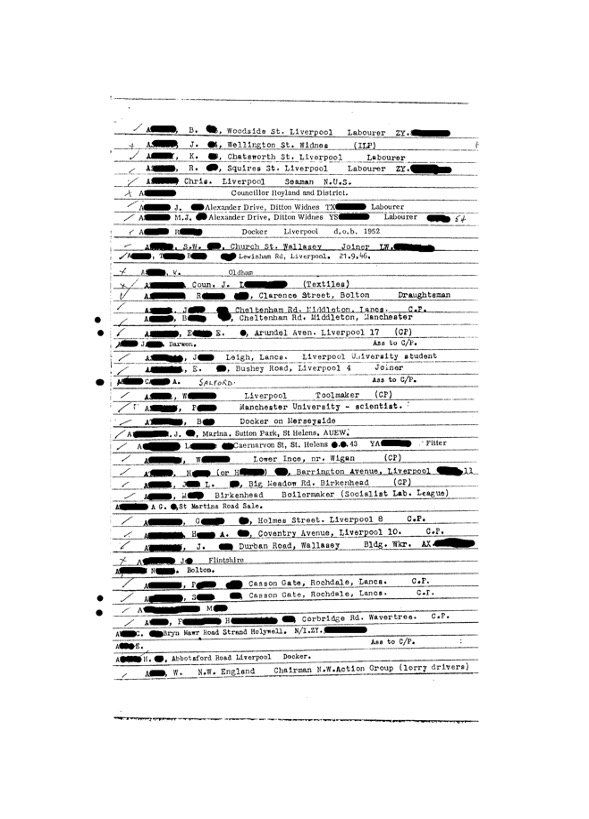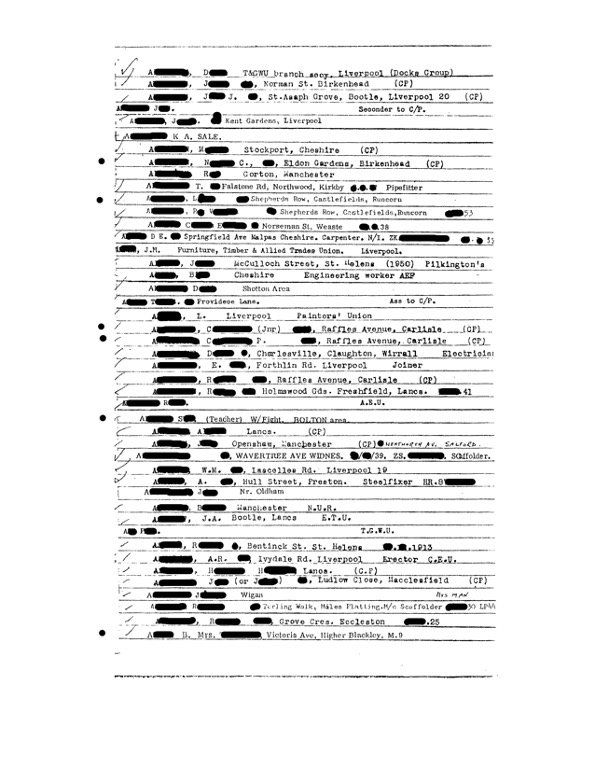GET A REAL FEEL FOR THE SCALE AND REALITY OF THE BLACKLIST BY DOWNLOADING THESE DOCUMENTS
CLICK HERE FOR AN EXCEL SPREADSHEET WITH DETAILS OF 1,150 BLACKLIST PAGES
Click here to download the overview of two Economic League blacklist indexes as a pdf
Click here to download a page by page analysis of Economic League Central Council's blacklist index as a pdf
Click here to download a page by page analysis of Economic League NW region's blacklist index as a pdf
Anatomy of the Blacklist
This short paper written for the previous incarnation of the website presents an overview of the Economic League based on a copy of the index of its North West Regions local blacklist from 1980. It is illustrated with the first four pages of the list, published here for the first time, but heavily redacted to prevent individuals being identified. We have two copies of League Blacklists. The North West Regions list and a larger central League list.
This short paper presents an overview of the Economic League based on a copy of the index of its North West Regions local blacklist from 1980. It is illustrated with the first four pages of the list, published here for the first time, but redacted to prevent individuals being identified.
Background
Until 1980 the League's research activities , primarily blacklisting, had been coordinated by the London Region. In 1980 its Director General, Peter Savill, personally took control of it and moved it to special offices in Thornton Heath and instructed regional offices that all regionally held files were to be moved there.
These pages are taken from North West’s regionally held blacklist. Savill’s reforms caused significant discontent and the regional director, Richard Brett, was very active internally and then outside the organisation in voicing his concerns. While he complied with instructions to return the files to Thornton Heath, he photocopied copied the index of these files held on a Kardex system. Later they were passed on to “World in Action” and formed the basis of a series of investigative programmes exposing the league. I believe Paul Foot, the great Daily Mirror and Socialist Worker investigative journalist, took the list to a Labour Party conference where for a small donation attendees could look up their name to see if it was there.
However it has never been openly circulated and for obvious reasons about related to privacy and the desire to avoid making the blacklisters job easier those who have access to it are reluctant to make it available. But the problem with this is that it has been hard for people concerned about blacklisting to get across the scale and nature of the blacklist.
This paper is a first attempt to remedy this, and to hopefully highlight the fact that The Consulting Association’s blacklist was not just as it happens compiled by a former League Employee, and similar to League’s, as witnesses to the Scottish Parliamentary Select Committee had tried tho suggest. It was the continuation of that part of the Economic League’s blacklist which covered the the construction industry. Together with a handful other companies including Fords, these companies paid an additional to be members of the Service Group of the Economic League.
This is would explain why, according to Ian Kerr giving evidence to the Scottish Select Committee, Sir Robert McAlpine paid £10,000 to the League for the list. Jack Winder, the Director General at the time of the League’s insolvency, disputed this suggesting that there was no need for the companies to “buy” a list that was their own already. This mysterious disagreement could be explained by the fact that when the league shut up shop it announced the files had been destroyed by the security firm Securicor (in which case there should have been nothing to buy), and also raises the question about whether the exchange of money its purpose was disclosed to the official receiver.
Redaction and Image Manipulation.
The pages used to illustrate this paper have been redacted to prevent individuals being identified while still allowing a feel for the style and content of the list being maintained.
- Forenames and surnames have been reduced to a single initial, on these Sheets all the Surnames begin with “A”.
- Where the redaction of a number masks the obvious gender of of the individual a bullet point has been drawn in to indicate the blacklisted individual was a woman. Those entries without a bullet are either male or ambiguous.
- House numbers and names have been redacted, but the rest of the address remains as it was typed or written on the top of the Kardex Card.
- Date of birth as been reduced to simply the year.
- National Insurance numbers have been redacted after the first two or three characters.
- Job roles and union positions and political affiliations have not been redacted
The original list is on A4 photocopied sheets and the image is less the A4. On these sheets most of the handwritten text and marginalia have been made by researchers using the list not by Economic League staff.
Photoshop has been used to crop the image on the photocopy sheet to the margins of the Kardex index, and to straighten the image. The image for use here has then been then been saved as a bit map to reduce the file size with the result of some loss of resolution.
Abbreviations particular to these files
CP ass = Assent given to the receiving officer for another person to stand for election for the Communist Party
NI = National Insurance
Union names should be straightforward to identify
The Kardex System
The Kardex system is a proprietary brand for a card index, that is an analogue and physical database. In the hands of experts it could be as structured as a modern database. It is clear from these four pages that there is little structure to this index, apart from surname first, then second and middle names and address following that.
Other information and press cuttings or cross references to other material could be on the cards but we don’t know what form this took. What we know is that that the index includes information likely to be useful for identifying the individual. For some that not very prominent individuals that would need to include DOB and NI, but one vey brief entry which indicates just the name and “Manchester” actually refers to a very well known Labour Party MP.
You can get an idea of what was on the cards from these examples which were liked at the same time as the list and have been redacted because they have been in the public domain for some time and weren't objected to.
The inclusion of a date birth would suggest the employer or prospective employer, or an official document was the source of that information.
The inclusion of the National Insurance number would strongly suggest that an employer or prospective employer was the source of the information. This also suggests that the person would work in an area of interest to the Services Group.
Political affiliations are likely to have been gathered by the League’s regional officers who could sometimes act as infiltrators.
While the police and possibly MI5 may have provided some information to the League there is nothing on the cards that would indicate which records might contain such interest.
The hoovering up of the names of assenters to bring parties was a routine practice., so on this list we find assentors to the Communist Party and the National Front.
Size of the list
Most of the photocopy sheets include around 40 names, although there are few entries for organisations such as “Advance”. All the names included in the list were of people living in the North West Region which included North Wales, Lancashire, Cheshire and Cumberland. There are around 7000 entries from these areas. in the full list - twice the size of the Consulting Association blacklist for the whole of the UK. At its largest (when these photocopies were made) it is possible to estimate that there will have been considerably in excess of 40,000 on the various regional lists compiled by the Economic League on behalf of their subscribers.
Blacklisting is for Life
As can be seen form the dates of birth given on the the index some of those included on the list had were already in the seventies in 1980. Once on the list you were never removed since there was no programme of data cleaning. And even youthful and fleeting engagement with radical thought and politics could follow you to the grave and then beyond…..




